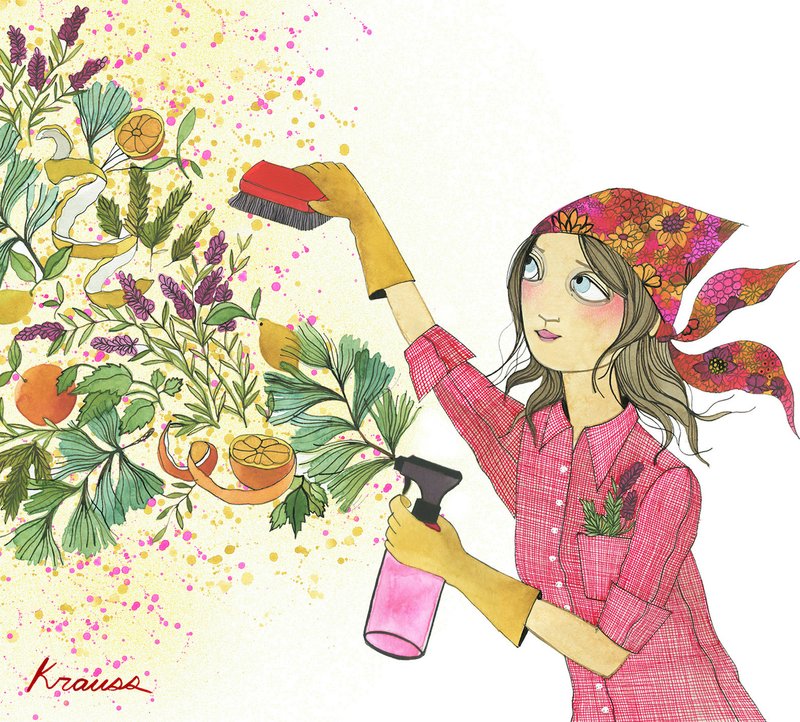In an age when practically anything can claim a spot on social media, the lowly kitchen cleaner spray is having its day — reimagined as a curated, crafty and oh-so-pretty countertop accessory.
Search Pinterest for a recipe for homemade cleaners and hundreds of suggestions pop up, with photographs of glass spray bottles surrounded by artful arrangements of lemons, rosemary and essential oils. Mason jars packed with orange peels and vinegar promise a fragrant and inexpensive way to clean the counter.
Those utilitarian plastic bottles that live beneath our sinks — it doesn't get less exciting than oven cleaner, am I right? — can hardly compete with these Instagram-worthy creations that rival the aesthetic appeal of a plate of freshly baked cookies. Stack a bunch of homemade toilet cleaning bombs (balls made of baking soda, hydrogen peroxide and citric acid) in a glass jar and suddenly one of a homeowner's grossest chores has a tool that's downright adorable.
"Why do I have to have a florescent green bottle on my counter? Why can't it be pretty? Why can't it be in a glass bottle?" said Becky Rapinchuk, the author of Clean Mama's Guide to a Healthy Home. "If it's cute, it might be a little bit more enjoyable."
The interest in do-it-yourself cleaning formulas comes out of a growing anxiety that the products sold on supermarket shelves can contain harmful chemicals. Many can include volatile organic compounds, known to cause asthma, headaches, allergic reactions and potentially even cancer or organ damage.
When the Environmental Working Group, a nonprofit advocacy organization, reviewed more than 2,000 cleaning products, it found that more than half contained ingredients that irritate the lungs. Common organic pollutants are as much as five times higher indoors than outdoors, according to the Environmental Protection Agency.
Look to the label for clarity, and you're unlikely to find much useful information because companies are not required to disclose their ingredients, and few products do. Products labeled "green" or "natural" may bend terms like "plant-based" to describe substances that have undergone extensive chemical manipulation before they reach your countertop, and may be no safer than their synthetic alternatives, according to Joe Schwarcz, the director of McGill University's Office for Science and Society. "There is a lot of very questionable marketing there," he said.
And so, suspicious of what's sold in stores, people have turned to what's in their pantries, drawn to the alluring possibility of cleaning up with ingredients safe enough to eat. Vinegar, for example, works as a disinfectant and breaks down unwanted residue like grease and soap scum; and baking soda deodorizes and is effective as a mild abrasive.
It's no wonder that cleaning the bathroom has elbowed its way into the self-care category. Tidying is no longer a Saturday morning chore, but a clear avenue to personal betterment and spiritual enlightenment. Consider Marie Kondo, who has become an expert of home organizing by showing desperate homeowners, first in her books and then on her popular Netflix show, how a well-folded shirt can turn a chaotic life into a calm one. The elevated household cleaner is a potential next step in the journey to transforming a home into a shrine of self-improvement. Take control of your toilet-bowl cleaner and maybe you can take control of your life, too.
But unlike clever folding methods, cleaning products involve chemistry — not just anything works. Household cleaners are a $6 billion industry in the United States, with products that are produced and tested by scientists who know far more about chemistry than I do. Could a recipe on a Pinterest board really deliver anything on par with what experts working in a lab for a multinational corporation can make?
Some do-it-yourself recipes are questionable. Mix a base with an acid — like vinegar with baking soda — and you get a voluminous chemical reaction that looks exciting, but ultimately leaves you with salt water. Some cleaning agents, like borax, bleach and ammonia are potentially harmful. Combine a chemical like ammonia with bleach and you produce a noxious gas that could do serious damage to your lungs.
"You can't mix things willy-nilly," said Rapinchuk, who sells a line of cleaning products on her website. "You have to be smart about it."
I do see the merits of escaping the cleaning aisle at Target — I don't exactly experience joy buying floor cleaner. A few weeks ago, I bought a set of glass spray bottles and made a wood cleaner using vinegar, olive oil and essential oils. I demonstrated my little experiment to my mother, spraying the solution on my dining room table to show her the surprisingly decent results. "So you're basically cleaning your table with salad dressing," she said.
True enough. But vinegar is a disinfectant, and oil protects wood. So shouldn't this recipe do the trick?
I asked Schwarcz, who told me that the go-to favorites among the do-it-yourself crowd — vinegar, baking soda and soap — can handle ordinary household grime. Unless you're cleaning up after the flu or a stomach bug, you don't need an army of powerful chemicals to get the job done. "You don't have to use a jackhammer to kill an ant," he said.
So my salad dressing concoction does actually clean my table. With its sleek glass bottle and cute handwritten label, it may even be worthy of a spot on my Instagram.
HomeStyle on 03/14/2020

